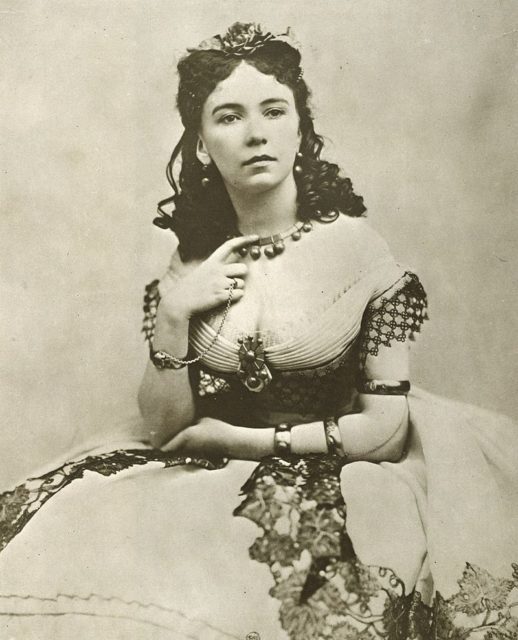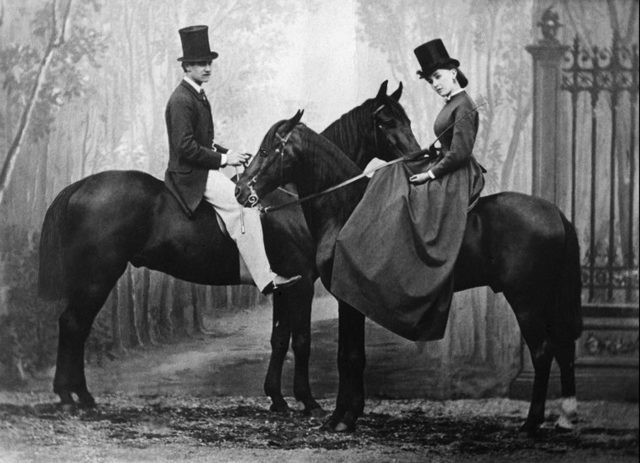Cora Pearl was a 19th-century courtesan, well-known in the French society which enjoyed her illustrious notoriety during the time of the Second French Empire. Performing as a street courtesan, she made an instant connection with a client, Monsieur Roubisse, who moved her to a more appropriate accommodation, taught her the business essentials of her street trade, and educated her in promoting and expanding her range of specialized skills.
Six years later, she was in love with his all-encompassing influence and despaired of ever leaving him. However, her fate had other plans, and her tutor died of a heart attack.

Her first lover of influence was the multi-titled, twenty-five-year-old Victor Masséna, the third Duke du Rivoli at the time, and later the fifth Prince of Essling. He treated her in luxury, inundating her with jewels, servants, a private chef, and money. When she went to the horse races and the casinos in the chic resort of Baden, Germany, he provided her with gambling funds. He bought her a horse, and she became an accomplished equestrienne. It was noted that she could ride like an Amazon and was gentler to her horses than to her paramours. Her companionship with Masséna lasted five years, while she was simultaneously sharing her services with Prince Achille Murat, a man who was a bit older than Masséna.
By 1860, Miss Pearl was one of the most famous upper-class prostitutes in Paris. She was the mistress of many prominent aristocrats, including Ludovic the Duc de Grammont-Caderousse, the Prince of Orange, next in line to the throne of the Netherlands, and most importantly, Charles Duc de Morny, half-brother of the Emperor Napoleon III.

The Emperor’s brother generously contributed to the luxurious life demanded by Pearl. In 1864, Pearl rented a château in the region of the Loiret known as the Chateau de Beauséjour – “beautiful sojourn.” It was an extravagantly adorned residence of impeccably-maintained interiors and grounds, upscale furnishings, and stained glass windows.
Her private bedchamber included a customized bronze bathtub decorated with her interlinked initials. The château was conceived for hosting gala events. The chef was instructed to spare no food for the fantastic meals. There were seldom fewer than fifteen guests at the dinner table, and Pearl had a reputation for creating leisure entertainment that was unexpected, outrageous, and excessively dramatic.

Of course, at these festivities, she was the principal attraction. During one of these gala events, she dared the dinner guests to get ready to slice into the next dish about to be served. What happened next was astonishing! The dinner’s next course was Cora Pearl herself! She demurely appeared lying on a huge silver platter completely naked, sprinkled with parsley and carried in by four large men costumed as waiters.
Napoléon Joseph Charles Paul Bonaparte, Emperor Bonaparte’s prominent cousin, was her most enduring admirer and a devoted provider.
She met the exceedingly rich, 42-year-old prince in 1868, and their liaison lasted for nine years, the longest relationship in Pearl’s vocation. He bought her several homes, one of them an original palace, “Les Petites Tuileries.”
In 1860, at a masquerade ball with the elite of Parisian society, she caused an astonishing spectacle when she appeared as a scantily-costumed Eve, whose degree of nudity deviated very little from the original in the Bible verses. Pearl always seemed enthusiastic about revealing her physical charms to an audience.
In 1867, she took the role of a singing Cupid in the Jacques Offenbach’s operetta Orpheus in the Underworld, performed at the Theatre Bouffes-Parisien. It was noted that Cora Pearl appeared on the stage half-naked. That evening the full membership of the all-male Jockey Club was present in the theater. Nearly every man of French nobility was there. It was a huge success, though of a different kind.

The pinnacle of Pearl’s vocation as a courtesan were the years from 1865 to 1870. In The Pearl From Plymouth, the biography of Cora Pearl written by W. H. Holden in 1950, it is written that Pearl sent money on a regular basis to both her father in America and mother in England. In Cora Pearl’s mind, money was to be spent to amass the luxuries of life and purchase her a position onto the top social scale.
Her wardrobe was custom made for her by the distinguished designer and tailor, Charles Frederick Worth; her jewelry alone was estimated to be valued at one million francs and, at one point, she was the owner of three homes. As her vocation prospered, the gifts from her benefactors needed to be both expensive and inspiring. She made rivals of her suitors, pitting one against the other and escalating the price for her favors as the game between the competitors heightened. At her peak, she was able to demand as much as ten thousand francs for an evening spent with her.
She dressed inventively, always with the intent of inciting shock or awe or both! Théodore de Banville wrote of her fascination for dyeing her hair in bold colors. Once she was seen riding in her coach, her hair dyed the color of a lemon, matching the yellow satin interior of the carriage. She once appeared in a blue gown, and her dog’s coat was dyed to match her dress. She was an advocate of the expressive made-up face, using makeup for her eyes and eyelashes, and applying fine facial powder highlighted with silver or pearls to give her skin a bright luminescence.
Her make-up was once described as “outrageously overstated.” In 1867, a drink named The Tears of Cora Pearl became popular, as it was inspired by Pearl. Also, in 1867, Alfred Delvau noted a tribute to Pearl in The Pleasures of Paris: “Today Madame, you are the preoccupation, the scandal, the renown, and the toast of Paris, at once, all of these things. Any talk, anywhere, is only about you.”
